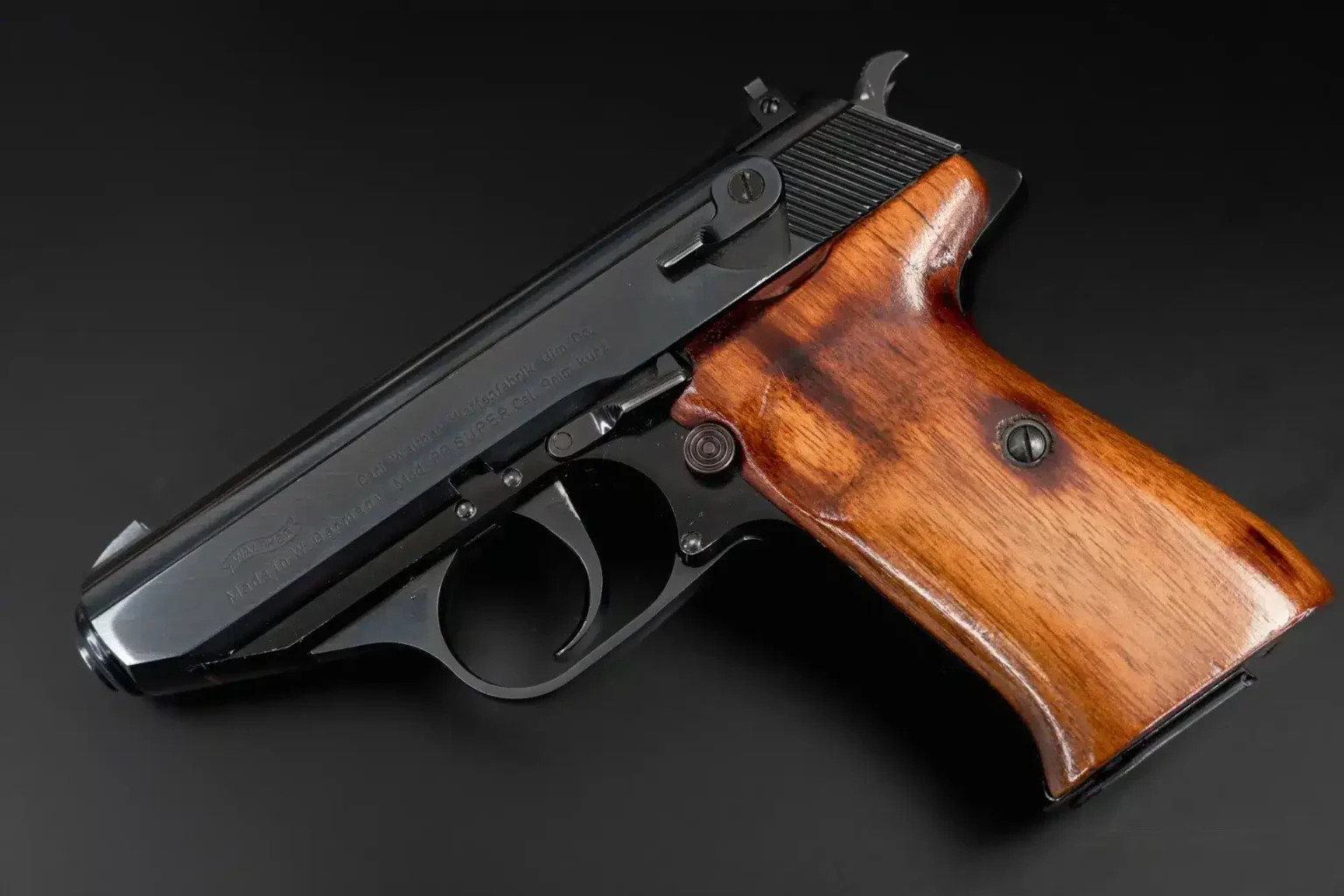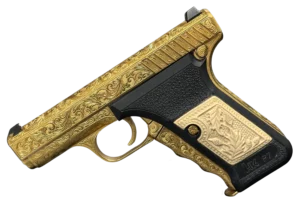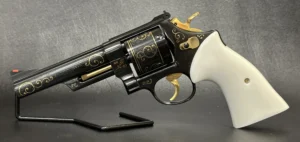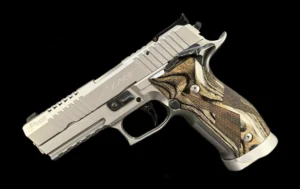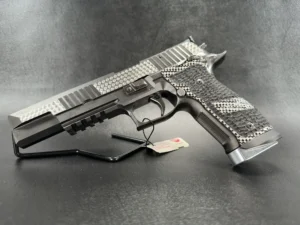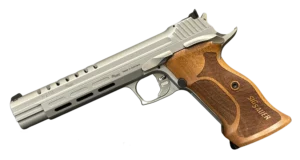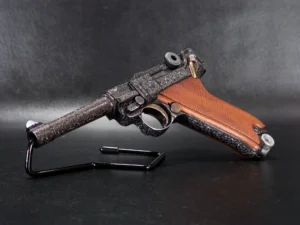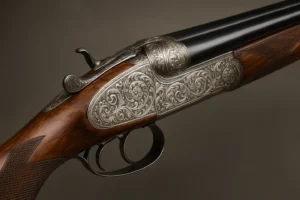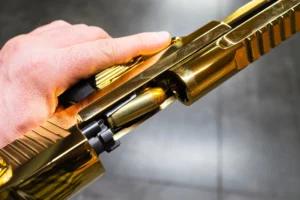Key Takeaways:
- Walther didn’t just survive history — it helped shape it: From humble beginnings building hunting rifles in 1886 to redefining handguns with the PP, P38, and beyond, Walther has consistently been at the edge of innovation. They didn’t chase trends — they quietly started them.
- These guns aren’t just functional — they feel right: There’s something weirdly personal about holding a Walther. Whether it’s the slim PPS or the competition-built Q5 Match, the ergonomics, the balance, the craftsmanship — it all feels like it was made with actual humans in mind. Not just spec sheets.
- Behind the James Bond glitz is a legacy of serious performance: Yeah, the PPK made it to the big screen. But Walther’s real impact is in its engineering — durable, dependable pistols trusted by professionals worldwide. It’s less about flash, more about firearms that work when it counts.
Let’s be honest: when people talk about iconic gunmakers, Walther doesn’t always get top billing in casual conversation. But it should. Because for those who’ve actually paid attention — the collectors, the cops, the history buffs, and yeah, even the movie nerds — Walther isn’t just “some old German brand.” It’s a cornerstone. It’s precision wrapped in steel and function dressed in style.
And somehow, it’s managed to stay relevant for over a century without losing its edge.
So, let’s walk through it. No buzzwords. No corporate lingo. Just a real look at what makes Walther tick — from the early days of bolt-action rifles to the pistols that have quietly (and sometimes not-so-quietly) changed everything.
From Hunting Rifles to Headlines
Carl Walther opened shop in 1886. That’s pre-electric-toothbrush, pre-World-War-anything. Back then, he was just building hunting rifles. German woods. Precision machining. All very old-world.
But here’s the thing — those rifles? They were good. Like, really good. Not flashy, not mass-produced. Just built right. That set the tone for everything that came next.
Fast forward to the early 20th century, and Carl’s sons start pushing into handgun territory. That’s when things start to get interesting. The shift wasn’t just about diversifying — it was a deliberate move toward a faster, more flexible firearm future. And it worked.
By the time the 1920s rolled around, Walther had done something no one else had quite pulled off yet…
The Walther PP: The Pistol That Changed the Rules
In 1929, Walther dropped the PP. Not a PP. The PP. And yeah, the name sounds funny now — but back then, it stood for “Polizeipistole.” It was sleek, easy to carry, and most importantly, it had a double-action trigger system. That was a big deal.
Double-action meant you could pull the trigger and fire without manually cocking the hammer first. In practice? It meant faster draws, fewer missteps, and an entirely new kind of safety and efficiency. Cops loved it. So did anyone else who actually needed their gun to work under pressure.
The PP set off a wave. Its DNA is all over the modern pistol landscape. But it was just the beginning.
War, Reinvention, and the Rise of the P38
Then came the war. Walther’s P38 was basically the German answer to the aging Luger — and let’s be real, the Luger looked cool but was finicky as hell. The P38? Not so much.
It was durable. Easy to disassemble. Functioned like a workhorse. And it introduced features we now take for granted, like decocking levers and open-top slides that made jams less likely.
There’s a reason militaries studied the P38 long after the smoke cleared.
And after the war? Walther didn’t crumble. They rebuilt. Literally moved operations to Ulm and started fresh — same name, same attitude, new start.
The Ulm Factory: Where Precision Still Has a Pulse
Today, Walther’s headquarters is in Ulm, Germany — and yeah, it’s as high-tech as you’d expect. But it’s not just about machines and automation. It’s also about tradition.
Inside that factory, you’ve got engineers working with some of the best metal-forming tech on the planet… right alongside artisans who hand-check parts with an eagle eye for detail. The vibe? It’s like a watchmaker’s shop collided with a sci-fi lab.
That’s probably why Walther guns don’t feel like mass-market plastic bricks. They feel intentional.
The Heavy Hitters: Walther’s Greatest Hits
Let’s talk about some of the standouts — the models that made people stop and pay attention.
Walther PPK: The Spy Gun That Actually Works
You already know this one. James Bond. Silencer. Tuxedo. Walther PPK.
Introduced in 1931, it was basically a shorter, leaner version of the PP. Perfect for concealed carry before “concealed carry” was a trend. People loved how it looked — but they really loved how it shot.
It wasn’t just for looks. It was compact, simple, and had just enough kick to matter without rattling your wrist. To this day, the PPK is still one of the most iconic pistols ever made.
Funny how a tiny little pistol meant for detectives ended up as a pop-culture juggernaut.
Walther PPQ: The Modern Fighter
If the PPK is the classy uncle, the PPQ is the gym-rat cousin with a degree in mechanical engineering.
Released in 2011, the PPQ is Walther’s take on the modern striker-fired pistol. Ergonomically, it’s a dream — seriously, pick one up and you’ll see what I mean. The trigger? Clean. Crisp. A weirdly satisfying break.
It’s not trying to be flashy, but in terms of performance, it’s up there with anything Glock, SIG, or HK has thrown into the ring. And unlike some of those brands, the PPQ isn’t trying to reinvent the wheel — it’s just trying to make the wheel spin smoother.
Walther PPS: Slim, Sharp, and Ready
The PPS doesn’t yell. It doesn’t posture. It’s just… there. Waiting. Quietly dependable.
It’s the go-to for folks who carry every day but don’t want to compromise on shootability. It’s slim — hence “Schmal” — and it disappears inside a waistband like a magician’s trick. But when it’s time to shoot, it doesn’t feel like a mouse gun.
You get a real grip. Real accuracy. It’s not a range toy — it’s a serious tool for people who don’t play around.
Walther Q5 Match: For People Who Like Winning
Then there’s the Q5 Match. This thing? It’s all muscle and finesse. Built for competition but not overly precious about it.
Optics-ready, precision trigger, adjustable sights — all the bells and whistles. But none of it feels bolted on. The design flows. The controls are intuitive. It’s a gun that makes you feel like you shoot better than you actually do.
Which, let’s face it, we could all use once in a while.
Not Just Pretty Faces: The Specs that Matter
Okay, let’s pause and talk shop for a sec. If you’re new to guns or just never got into the spec-speak, here’s how Walther makes things easy.
- Caliber: Most models come in 9mm, which is the Goldilocks of handgun ammo — not too hot, not too soft. Some come in .380 ACP for easier control. Depends on what you’re using it for.
- Action: PPK is blowback. PPQ is striker-fired. One’s more old-school, the other’s a product of modern thinking. Different vibes, different advantages.
- Capacity: You’ll get anywhere from 6 to 17 rounds, depending on the model. More capacity usually means a bulkier gun — but Walther does a good job balancing size and firepower.
And then there’s the ergonomics — which Walther absolutely nails. Grips that feel like they were modeled on actual human hands. Controls that fall right where you expect them to.
Safety That’s Actually, You Know, Safe
Look — any good gunmaker bakes in safety features. But Walther goes a bit further.
Manual safeties. Trigger safeties. Loaded chamber indicators. Decockers. It’s all there — and it’s all engineered to be intuitive. You’re not hunting for a tiny button when something goes sideways.
And that’s kind of the point. Safety shouldn’t slow you down. It should just… work.
These Guns Last
Walther firearms aren’t the kind you baby in a padded case for 20 years and never shoot. They’re meant to be used.
They’re built tough. Tight tolerances. Quality metals. Thought-out designs that don’t punish you when it’s time to clean and maintain. And honestly, the manuals aren’t bad either — which is saying something in the gun world.
With basic care? These things last a lifetime. Maybe longer.
A Legacy You Can Actually Feel
Here’s where Walther gets a little poetic — and that’s okay.
Because this isn’t just a company that built a few cool guns and cashed in. It’s a brand that helped shape what handguns look like today. From military breakthroughs to civilian must-haves, they’ve always been somewhere in the background… nudging the industry forward without making a big scene about it.
That matters. Especially in a market where trends burn out faster than you can say “modular chassis.”
History Class, But Fun
Teachers and historians — you want a crash course in how 20th-century firearm design evolved? Start with Walther. You’ll hit all the high notes: pre-war innovation, wartime engineering, post-war reinvention, and 21st-century refinement.
Plus, let’s be real: telling kids about James Bond’s gun is a lot more fun than another chapter on trench warfare logistics.
Pop Culture Clout (Because We Can’t Not Mention It)
Look, the PPK and James Bond are permanently linked. That’s not just marketing. That’s cultural gravity.
But it goes deeper than that. Walther isn’t just “the Bond gun.” It’s been used by real-world agents, police departments, and militaries across the globe. It’s not a toy — it just happens to look good on screen too.
There’s something timeless about that combination: form meeting function in a way that still feels exciting.
Thinking About Buying One?
Here’s the deal. If you’re shopping for a Walther — first, congrats. Good taste.
But also: know what you’re after. Want something small for daily carry? PPS or PPK. Want a modern duty gun? PPQ or PDP. Into competition? Q5 Match. There’s something for every kind of shooter.
Hold a few. Shoot them if you can. See what fits. The right one will click. Literally.
Don’t Just Buy — Learn
Buying a gun is just the beginning. Learn how to shoot it. Clean it. Carry it safely.
Find a class. Talk to someone who’s been doing it for a while. Go to a range that won’t judge you. Walther gives you a great tool — but it’s on you to know how to use it right.
Final Thought (Or Maybe Just a Gut Check)
Walther isn’t the loudest brand out there. It’s not constantly chasing trends. It doesn’t care about tactical fanboy aesthetics or internet drama.
It just builds great guns.
Beautiful, functional, durable, dependable guns — the kind you pass down to someone who’ll actually use them. There’s something refreshing about that. In a world full of hype, Walther is substance.
And that? That never goes out of style.
Frequently Asked Questions
Walther firearms are celebrated for their exceptional German engineering, precision, and consistent quality. The brand has established itself as a leader in craftsmanship and innovative design, appealing to collectors, enthusiasts, and professional users.
The article highlights models like the Walther PPK, known for its connection to James Bond, and the Walther P38, a staple in World War II history. These models represent Walther’s dedication to combining form, function, and precision.
Walther introduced several pioneering features in the firearm industry, such as the double-action/single-action trigger system. The brand is also known for innovations that improve firearm ergonomics and performance, enhancing usability and reliability.
Walther firearms are revered for their historical significance and the high standard of German craftsmanship. Many models have a storied history and limited production runs, making them valuable additions to any collection.
You can explore Walther’s official website and visit trusted collector sites. Additionally, the article provides an insightful overview of Walther’s impact and contributions to firearm technology and design.


